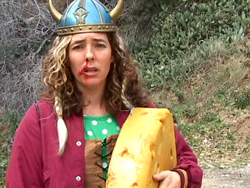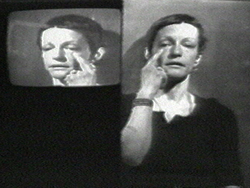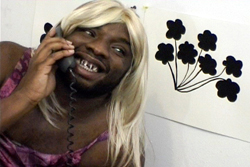Harry Dodge and Stanya Kahn
Related EAI Public Programs
The Movement Program
Electronic Arts Intermix (EAI) 264 Canal Street #3W
New York, NY 10013
June 25th, 2024
7:00 pm ET
RSVP here. Seating is first come, first serve. RSVP does not guarantee entry, but helps us track interest and send event updates and reminders.
EAI is pleased to present an evening highlighting the use of choreographic strategies in video art. While choreography as a method of sequencing movement for storytelling or affect is typically invoked in relation to dance, the application here broadens to consider a wide range of video art strategies, including the site gag, televisual editing techniques, and the associative organization of text and image. The program includes works by Burt Barr, Harry Dodge & Stanya Kahn, Alex Hubbard, Cynthia Maughan, Alix Pearlstein, Jacolby Satterwhite, and Stuart Sherman—a vibrant group of artists whose practices encompass dance, performance, sculpture, and digital animation.
Using their video cameras and editing techniques, the artists in this screening determine the structure of their work according to the recording apparatus itself, complicating the conventions of straightforward performance documentation. Viewed together, the works in this program represent the choreography of movement, character, and the framed scene as facilitated by video and digital technology, compiling the gestures of everyday life into a catalogue of kinetic experimentation.
Maughan’s Calcium Pills (1978) is a direct performance for the artist’s U-Matic camera whose framing reflects her dual role as camera operator and subject. In Barr’s The Elevator (1985), the fictive musings of two women, choreographers Trisha Brown and Wendy Perron, are moulded into a fragmented narrative through the repetitive use of a snap zoom timed with the open and close of elevator doors. Sherman’s Video Walk (1987) animates a pair of sneakers appearing to walk across shifting landscapes on a CRT screen to make a visual pun of the transportive qualities of broadcast television, while Pearlstein’s Pet, Fluffy, Cheezy, Bunny… (1993) strings together a dreamlike selection of public domain images, videos, and sound to reflect the artist’s associative thought patterns. Dodge and Kahn’s Whacker (2005) uses cleverly-timed cuts to comedically portray the durational feat of a woman mowing a tall hill of dead grass in a sundress and high heels, and in Cinepolis (2007), Hubbard composes a dynamic scene as he eviscerates five Mylar balloons atop a projector screen-turned-canvas—reminiscent of Modernist experiments in kinetic sculpture making use of household and found objects. A rich digital animation created in collaboration with the artist’s mother, Satterwhite’s Reifying Desire 3: The Immaculate Conception of Doubting Thomas (2012) concludes the program with an explicit depiction of dance in which the use of on-screen text and computer-generated performers and environment expand the “subject” of choreography beyond the biological human body.
This event is programmed by Charlotte Strange, EAI's Public Engagement and Development Associate, as a part of an invitation to EAI staff to organize public screenings drawn from the collection. An open Q&A will follow the screening.
Electronic Arts Intermix (EAI)’s venue is located at 264 Canal Street, 3W, near several Canal Street subway stations. Our floor is accessible by elevator (63" × 60" car, 31" door) and stairway. Due to the age and other characteristics of the building, our bathrooms are not ADA-accessible, though several such bathrooms are located nearby. If you have questions about access, please contact cstrange@eai.org in advance of the event.
If you are feeling sick or experiencing symptoms that could be related to COVID-19, we ask that you please stay home.
EAI is pleased to present an evening highlighting the use of choreographic strategies in video art. While choreography as a method of sequencing movement for storytelling or affect is typically invoked in relation to dance, the application here broadens to consider a wide range of video art strategies, including the site gag, televisual editing techniques, and the associative organization of text and image. The program includes works by Burt Barr, Harry Dodge & Stanya Kahn, Alex Hubbard, Cynthia Maughan, Alix Pearlstein, Jacolby Satterwhite, and Stuart Sherman—a vibrant group of artists whose practices encompass dance, performance, sculpture, and digital animation.
Using their video cameras and editing techniques, the artists in this screening determine the structure of their work according to the recording apparatus itself, complicating the conventions of straightforward performance documentation. Viewed together, the works in this program represent the choreography of movement, character, and the framed scene as facilitated by video and digital technology, compiling the gestures of everyday life into a catalogue of kinetic experimentation.
Maughan’s Calcium Pills (1978) is a direct performance for the artist’s U-Matic camera whose framing reflects her dual role as camera operator and subject. In Barr’s The Elevator (1985), the fictive musings of two women, choreographers Trisha Brown and Wendy Perron, are moulded into a fragmented narrative through the repetitive use of a snap zoom timed with the open and close of elevator doors. Sherman’s Video Walk (1987) animates a pair of sneakers appearing to walk across shifting landscapes on a CRT screen to make a visual pun of the transportive qualities of broadcast television, while Pearlstein’s Pet, Fluffy, Cheezy, Bunny… (1993) strings together a dreamlike selection of public domain images, videos, and sound to reflect the artist’s associative thought patterns. Dodge and Kahn’s Whacker (2005) uses cleverly-timed cuts to comedically portray the durational feat of a woman mowing a tall hill of dead grass in a sundress and high heels, and in Cinepolis (2007), Hubbard composes a dynamic scene as he eviscerates five Mylar balloons atop a projector screen-turned-canvas—reminiscent of Modernist experiments in kinetic sculpture making use of household and found objects. A rich digital animation created in collaboration with the artist’s mother, Satterwhite’s Reifying Desire 3: The Immaculate Conception of Doubting Thomas (2012) concludes the program with an explicit depiction of dance in which the use of on-screen text and computer-generated performers and environment expand the “subject” of choreography beyond the biological human body.
This event is programmed by Charlotte Strange, EAI's Public Engagement and Development Associate, as a part of an invitation to EAI staff to organize public screenings drawn from the collection. An open Q&A will follow the screening.
Electronic Arts Intermix (EAI)’s venue is located at 264 Canal Street, 3W, near several Canal Street subway stations. Our floor is accessible by elevator (63" × 60" car, 31" door) and stairway. Due to the age and other characteristics of the building, our bathrooms are not ADA-accessible, though several such bathrooms are located nearby. If you have questions about access, please contact cstrange@eai.org in advance of the event.
If you are feeling sick or experiencing symptoms that could be related to COVID-19, we ask that you please stay home.
45 YEARS OF PERFORMANCE VIDEO FROM EAI
P.S.1 Contemporary Art Center 22-25 Jackson Ave at the intersection of 46th Ave
Long Island City, NY 11101
November 1, 2009 - April 26, 2010
Thursday - Monday, noon - 6 pm
EAI presented 45 Years of Performance Video from EAI, a survey of four decades of artists' engagement with video and performance. This project is presented in conjunction with 100 Years, an exhibition on the history of performance art organized by P.S.1 Contemporary Art Center and Performa 09.
EAI @ THE NY ART BOOK FAIR 2009
The NY Art Book Fair 2009
P.S.1 Contemporary Art Center 22-25 Jackson Ave at the intersection of 46th Ave
Long Island City, NY 11101
Opening Reception: Thursday, October 1, 6-8 pm
Friday & Saturday, October 2-3, 11 am - 7 pm
Sunday, October 4, 11 am - 5 pm
EAI participated in The NY Art Book Fair 2009, organized by Printed Matter at P.S.1 Contemporary Art Center. EAI's project space, installed in P.S.1's basement vault, presented FREE TRADE, a program of videos exploring economies of exchange in a globalized world: the circulation of art, ideas, information and capital. On view were new and historical works, drawn from EAI's extensive collection, by artists including Chris Burden, Bernadette Corporation, Martha Rosler, Dan Graham, VALIE EXPORT, Dara Birnbaum, Kalup Linzy, Seth Price, Lawrence Weiner, Harry Dodge and Stanya Kahn, Ken Jacobs, Gordon Matta-Clark, Muntadas, Takeshi Murata, Leslie Thornton and Ryan Trecartin.
CHARACTER WITNESS
EAI Video Project Space X Initiative
548 West 22nd Street, Ground Floor
New York, NY 10011
Tuesday, June 23, 2009 - Friday, July 3, 2009
On June 23rd, EAI's project space will launch with Character Witness, a program of videos by artists who take on the role of actor in their own narratives. Featuring a cross-generational group of artists, including Kalup Linzy, Alex Bag, Michael Smith, MICA-TV, William Wegman, Harry Dodge and Stanya Kahn, and Nancy Holt and Robert Smithson, these works also share a focus that resonates in the current economic and cultural climate: The irreverent investigation of the artist in relation to the art world and the art market.
In casting themselves in their own stories, the artists pursue a range of strategies, from playing or voicing a suite of multiple characters to performing alongside an ensemble cast or assuming fictionalized versions of themselves. Blurring the lines between narrative, performance and documentary, the artists take on these roles to critique, question, and satirize the systems around the marketing of the artist and the selling of their art.
In casting themselves in their own stories, the artists pursue a range of strategies, from playing or voicing a suite of multiple characters to performing alongside an ensemble cast or assuming fictionalized versions of themselves. Blurring the lines between narrative, performance and documentary, the artists take on these roles to critique, question, and satirize the systems around the marketing of the artist and the selling of their art.




